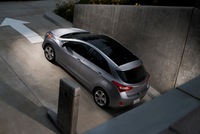2013 Hyundai Elantra GT Review By Thom Cannell
By Thom Cannell
Michigan Bureay
The Auto Channel
If your image of the 2013 Hyundai Elantra Coupe suggests the sleek profile of a Tiger shark, the 2013 Elantra GT is a Great White; bolder nose, more teeth, and a lot more muscle. This European-designed hatchback swims in a lagoon filled with hearty eaters like Mazda’s Mazda3, Ford Focus, Volkswagen Golf, Toyota Matrix, and Subaru Impreza. All circle the $20-$24,000 price point.
Elantra GT competes by delivering competitive power (148 horsepower and 131 pounds-feet of torque) which bests the others except Focus and Mazda3, who have larger engines. A 6-speed automatic and 6-speed manual keeps them swimming with similar sharks and an EPA fuel economy of 28 City and 39 Highway (auto) bests or equals other hungry foragers. Hyundai’s advantages over those are many, not the least a price advantage of $920 to $1,125 for automatic models plus a longer warranty in every area, and the largest group of standard features in the shiver—an appropriate name for this finback gang.
 |
Though the 2013 Elantra GT features sculpted headlamps and taillights similar to its equally fresh Coupe sibling, Elantra GT appears more aggressive, more snuggly wrapped with very different grille and shoulders. In comparison, the Coupe is more aerodynamic while GT adopts hunky crossover notes. This is why GT is rated to deliver one less MPG.
Our opinion is split whether the GT looks better from teeth or tail. At the rear is a deeply scooped rear window glass. US and Korean designers used vertical reflectors at the lower corners to define the GT’s broad and powerful rear. Poised above those deeply sculpted inset accents are wraparound tail lamps that harmonize with rearwards sweeping fenders, blending into a downwards sweeping line terminating at the bumper. Bonded to the sculpted hatch is a floating rear spoiler surfing above the rear glass.
Shark hunters, camera or bill in hand, say the GA’s more aggressive grille opening—jaws spread wide by piano-black cross bars—appears stuffed with horizontal teeth flanked by projector headlamps and crystalline fog lamps. GT’s front shoulder arches above lean wheel wells, visually stronger than other Elantras. Side views flow more visibly, cresting atop the wheel arch and flowing rearward to the tail.
Almost everything that defines the car is standard, from it’s three-position Driver Selectable Steering (comfort, normal, sport) and four-wheel disc brakes to hints of chrome at the base of its sweeping greenhouse, and wraparound tail lamps that emphasize a fluid line leading to the highly arched front wheels. Styling strikes hardest at the rear. Proportionally excellent with a visual balance between rear window with standard wiper and spoiler, the hatch includes a rearview camera hidden behind a flip-up badge. Those little red reflectors broaden and anchor the rear, pulling the car’s appearance tightly earthwards.
 |
A standard tilt-telescope steering wheel includes complete audio and cruise controls and frames a bright white-on-black instrument cluster. Digital gauges display stacks of fuel or temperature information and other notices, like open doors, appear above, topped by a multifunction odometer. We did wish for more contrast in the tachometer and speedometer when sunlight washed over our shoulders, otherwise it was crisp and clear. Oh, that sunlight often came from a segment-first panoramic sunroof.
 |
 |
Under the hood is an all-aluminum 1.8-liter Nu engine with multipoint injection. It knocks out a decent-in-class 148 horsepower and 131 pound-feet of torque. The engine mates to a six speed transmission, either automatic or manual. Either transmission makes the car feel sporty, pulling strongly (and quietly) from its torque peak of 4700 to over 6,000 without sounding like wound-up jet ski. Fuel economy for the manual is rated by EPA at 28/39, the automatic at 28/39 which is best-in-class.
One reason for its fun-to-drive character, departing from the numbness and squish of some recently driven Hyundai’s, is better on-center feel from the three-position adjustable steering which modifies on-center feel and how much assistance is delivered. We tried all three and Comfort suited all-day freeways, Normal fit most conditions, and we dialed up Sport for fast, twisting two-lanes. There’s only a gradual elasticity that easily permits using acceleration and deceleration to point the nose, inviting modestly spirited driving (though not in a class with Hyundai’s R-spec cars).
Another fun-maker is the unique rear suspension that uses specifically tuned front Macpherson struts and a rear V-beam torsionally-twisting suspension that incorporates larger front and 22 mm rear anti-roll bars. Also, Sachs dampers are tuned for each of two tire-wheel packages. We’re told the steering and suspension is not as tuned as the European version because of our poor roads. Another fact, Elantra GT is 9” shorter than Elantra 4-door with a 2” shorter wheel base at 169.3”. That equals lots more room in your garage. It’s a bit taller, 1.4” and wider by an iPhone thickness (0.2”), should that matter.
Elantra GT shines is in its style and value. A six-speed manual transmission GT lists at $19,170 including freight and includes features like fog lights, rear spoiler, trip computer, alarm system, bluetooth, satellite radio with USB, seventh air bag for driver’s knees, six-speed automatic with SHIFTRONIC, remote keyless entry that may be unobtainable from competitors. Just two option packages are available, the $2,750 Style Package adds a more highly tuned suspension, leather seats and surfaces, aluminum pedals, 17” alloys and that panoramic sunroof. That brings you to $22,920. Adding the Tech Package of 7” navigation with rearview camera, automatic headlights, proximity key and push-button start, and dual automatic temperature controls brings may bring your total MSRP to $25,270.
When you’re swimming with sharks watch for hunger. Watch Hyundai, it’s hungry.



